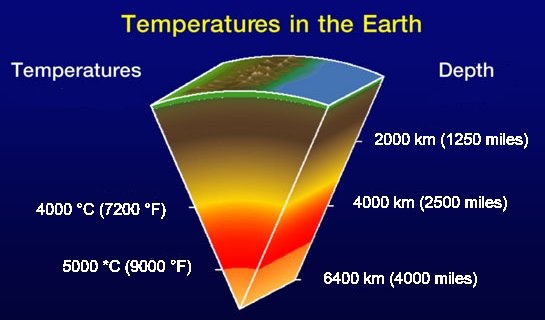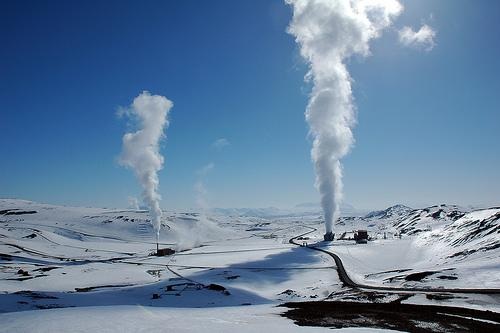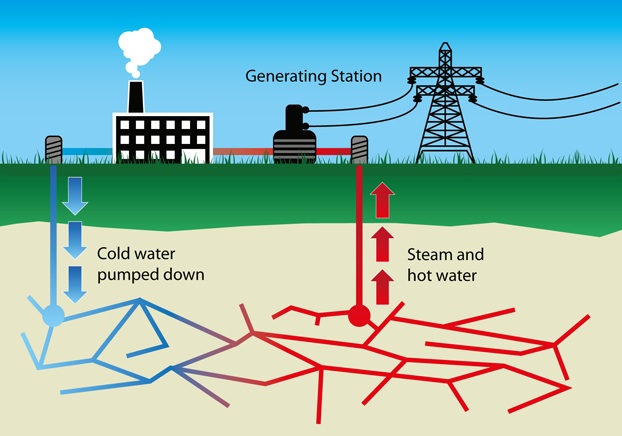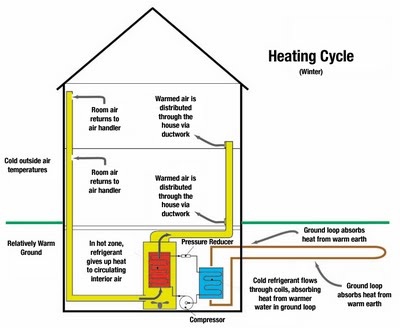A discussion covering the geothermal context, power generation, ground source heat pumps and geothermal's potential for the future.
Allan R. Hoffman | Thoughts of a Lapsed Physicist
Geothermal energy is heat from the earth and has been used by mankind for bathing and heating for centuries. The first power plant to use geothermal heat dates from 1904 in Larderello, Italy and it is still operating. Geothermal energy has an extensive and growing literature and my purpose in this blog is not to ‘reinvent the wheel’ but to add to the history where I have personal information that is not widely known, and to speculate on geothermal’s future. It is a large energy resource, in many ways the largest on earth, and one that is just in the early stages of realizing its potential.
Many useful references can be found on geothermal energy and its various manifestations and applications. I list three web references below as good places to start:
- Wikipedia: http://Wikipedia.org/wiki/geothermal_energy
- Union of Concerned Scientists: http://www.ucsusa.org/clean_energy/our-energy-choices/renewable-energy/how-geothermal-energy-works.html
- Geothermal Energy Association: http://www.geo-energy.org
Geothermal energy derives largely, but not exclusively, from radioactive decay of uranium, thorium and potassium in the earth’s core. Lesser amounts of core heating derive from heat released when iron cools and solidifies at the earth’s central core, mineral phase changes, friction heating associated with earth’s tides, and even impact collisions with matter from space. This heat convects and conducts up to the earth’s thin crust (just one percent of the earth’s mass) through various pathways and manifests itself as hot water and steam, hot rock, warm earth, magma and volcanic eruptions. We can think of the crust as a blanket on the rest of the planet.
This heat has been flowing from the center of the earth for more than 4.5 billion years and will continue as long as the earth exists, about another 5 billion years. Since this flow is limitless geothermal may be considered a renewable energy source . It also is constantly available and thus a baseload energy source.
Temperatures close to the earth’s center are about as hot as the sun’s surface (5,500C or 9,900F), and geologists estimate that the rate at which energy flows from the earth’s interior is on the order of 44 terrawatts (TW, millions of megawatts). The replenishment rate from radioactive decay is estimated to be about 30 TW. To put this number in perspective, today’s global installed electrical generating capacity is just over 5 TW.
Initially the core of the earth was a hot liquid but it has cooled over geological time and the core is now seen as an anisotopic very high temperature core of solid iron created under conditions of extremely high pressure. Somewhat above the core some rock is still molten, creating magma that convects upward since it is lighter than rock. The magma heats rock and water in the crust, creating hot water and steam at various points on and near the earth’s surface. It is estimated that the amount of heat in hot rock and water within 6 miles of the earth’s surface is more than 50,000 times as much as all the energy stored in the planet’s oil and natural gas resources.
How has this heat been used used in the past, how is it being used today, and how might it be used in the future? Historically, hot springs have been used for bathing by humans since Stone Age times and since Roman times for space heating. These uses are still present and growing, and the first district heating system in the U.S., in Boise, Idaho, was powered by geothermal energy starting in 1892. In Iceland 90 percent of the households are heated by geothermal energy. Other applications include desalination, agricultural drying and industrial heating, for a total of about 30 GWt.
In modern times geothermal energy is best known for its application to power generation and ground source (aka ‘geothermal’) heat pumps. I will say just a few words on each of these applications, and then focus on geothermal’s potential, which is huge.
Today’s geothermal power plants (called ‘hydrogeothermal’) use geothermal heat in the form of dry steam issuing from the ground, hot water that flashes into steam, or the vapor of a volatile liquid (such as isobutane) heated by hot water, to drive a turbine generator. The U.S. currently leads the world in geothermal power generation (3,200 MWe), followed by the Philippines (1,900 MWe), Indonesia (1,200 MWe), Mexico (960 MWe), Italy (880 MWe), New Zealand (770 MWe), and Iceland (660MWe). As of May 2012 twenty four countries had geothermal power plants, for a total generating capacity of 11,400 MWe. Future geothermal power plants will use so-called ‘enhanced geothermal/EGS’ (previously called ‘hot dry rock’) systems in which deep wells are drilled into hot rock with no natural water and water is introduced from and returned, heated, to the surface. Estimated global potential varies from 0.04 to 2 TW, depending on the depth of drilling and level of investment. Wells as deep as 6 miles are now common in the petroleum industry.
One piece of history about EGS: this technology was pioneered at Sandia National Laboratory with U.S. DOE support for many years post the Arab Oil embargo of 1973-4. In the mid 1990′s, when geothermal was one of the renewable energy programs I managed, I met in San Francisco with the heads of all U.S. geothermal power companies to discuss the technology’s future. It was a time of financial difficulty for the companies, limited Congressional budgets for renewables, and hard decisions had to be made on how to support a broad range of emerging technologies with federal funds. All at the meeting agreed that while hydrogeothermal was the basis of their existing businesses geothermal’s future was in hot dry rock. Not willing or able to have DOE support geothermal development close to 100 percent into the future, as had been true for many years, and being a strong believer in cost sharing to advance commercialization, I offered to meet the industry half-way on further EGS development – 50 percent DOE funding, matched by 50 percent industry funding – and to issue an RFP (Request For Proposals) committing DOE to that arrangement. Unfortunately, not one company submitted a proposal in response to the RFP (times were tough and anticipated energy costs from EGS were high) and I was forced to terminate the hot dry rock program. Today EGS is looking to be much more commercially attractive.
Air source heat pumps, well known and widely used, deliver heat to a house or other building that is drawn from outside air. The problem with such heat pumps is threefold: they sit outside and are exposed to weather elements, they use electric-powered air conditioning, and when heat is required and the outside air gets cold enough the heat pumps are effectively electric heaters. This increases electricity demand on the grid and can cause brownouts, as happened during a cold winter snap on the U.S. East Coast a number of years ago.
Ground source heat pumps, in contrast, exchange energy (heat and cool) with the ground (or underground aquifers), taking advantage of the fact that once one gets at least 10-12 feet below ground the ground’s temperature in most locations is reasonably constant at about 55F. Thus, a ground source heat pump can cool in the summer and heat in the winter (basically a reversible refrigeration cycle) and can be located inside a building where it is shielded from weather effects and more rapid aging.
Other advantages of such heat pumps are reduced peak demands on utility grids and reduced consumer energy costs. The disadvantage for consumers is the need to drill (and pay for) holes for the heat exchange with the ground, either deep vertical holes with heat exchanger tubing or more shallow holes with more numerous heat exchange loops of tubing. The tubing, filled with heat exchange fluid, is grouted to the earth to enhance heat exchange.
Another problem is that many heating and cooling contractors are still not familiar with ground source heat pumps and do not bring them to consumers’ attention. This was particularly true in the mid 1990′s when I had responsibility for DOE’s ground source heat pump program. There was some history – a ground source heat pump had been installed in a hotel in Kentucky in the 1980′s and its energy demand was shown to be less than that of an identical hotel in the same location outfitted with a traditional air exchange heat pump – but no commercialization took place. My response, once I understood the benefits of ground source heat pumps, was to initiate a joint program with the electric utility industry to educate people about ground source heat pumps and facilitate their deployment. This led to establishment of the Geothermal Heat Pump Consortium, now known as GeoExchange. One important utility response was to advance the money to homeowners for drilling the heat exchange holes, a major barrier to heat pump deployment, recognizing the utility benefits from peak power reductions. Consumers repaid the loans from the savings on reduced energy bills.
Today more than 600,000 ground source heat pumps are installed in the U.S., with new installations occurring at about 60,000 per year. The U.S. Defense Department is an increasingly heavy user of ground source heat pumps and pioneered in their use in the late 1990′s by installing 4,003 ground source heat pumps in military housing at a base in Louisiana. A side effect of the U.S. program was the introduction of ground source heat pumps to China in 1998 when I first went to China on a government-to-government visit. Today China is incorporating ground source heat pumps into many if not most of its new buildings.
Geothermal’s potential: hydrogeothermal’s potential is geographically constrained (conditions that make water circulate to the surface are found in less than 10 percent of the earth’s land area) but further growth is anticipated. One example is co-production of geothermal electricity in oil and gas wells that also produce lots of hot water.
EGS’s (enhanced geothermal systems) potential is huge, given that hot rock underlies all parts of the earth, but deep drilling is expensive and risky. At present the U.S., Japan, France, Germany and Australia are supporting EGS R&D programs.
Familiarity with ground source heat pumps is increasing and most new buildings, as we progress toward zero energy buildings, will probably incorporate them.
Direct uses of geothermal heat in space heating (and even cooling), agriculture and desalination are also increasing as people get familiar with their advantages and wide range of applications.
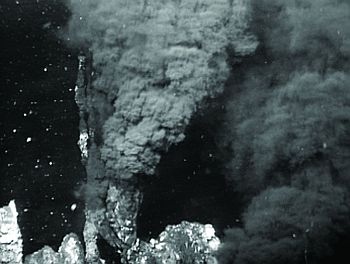 To close this discussion I would like to speculate on one other way to possibly use geothermal heat – tapping the hot fluids being expelled from hydrothermal vents (also called ‘Black Smokers’) at spreading fridges on the ocean floor. They are the result of cold seawater leaking through fissures in the ocean crust into hot magma below the crust, being heated and reemerging as hot water vents enriched with dissolved minerals (sulfur, copper, zinc, gold, iron). These minerals deposit out on the ocean floor when the heated water (some of these vents reach temperatures of over 700F) hits the cold seawater, creating massive deposits which obviously will attract commercial attention. The energy content of this hot water is also immense and represents one way of tapping the heat energy in magma. Needless to say, tapping this heat energy requires operating at great depths in oceans under extreme conditions, possibly bringing the hot water to the surface, and trying to do all this in a reliable and cost-effective manner. Intriguing, given the amount of energy potentially available, but obviously not on any anyone’s short- or mid-term agendas.
To close this discussion I would like to speculate on one other way to possibly use geothermal heat – tapping the hot fluids being expelled from hydrothermal vents (also called ‘Black Smokers’) at spreading fridges on the ocean floor. They are the result of cold seawater leaking through fissures in the ocean crust into hot magma below the crust, being heated and reemerging as hot water vents enriched with dissolved minerals (sulfur, copper, zinc, gold, iron). These minerals deposit out on the ocean floor when the heated water (some of these vents reach temperatures of over 700F) hits the cold seawater, creating massive deposits which obviously will attract commercial attention. The energy content of this hot water is also immense and represents one way of tapping the heat energy in magma. Needless to say, tapping this heat energy requires operating at great depths in oceans under extreme conditions, possibly bringing the hot water to the surface, and trying to do all this in a reliable and cost-effective manner. Intriguing, given the amount of energy potentially available, but obviously not on any anyone’s short- or mid-term agendas.
About me:
Trained in engineering and physics at Cornell University, ! worked as a research intern/physicist at IBM, Los Alamos National Laboratory, and Texas Instruments before obtaining my Ph.D in solid state (now condensed matter) physics at Brown University in 1967. After a post-doctorate at Brown I joined the Physics and Astronomy Department at the University of Massachusetts/Amherst as a faculty member in 1968. One year later I became close friends with a new faculty member, Dr. David Inglis, who had been part of the atomic bomb project at Los Alamos during WWII. He subsequently served as a senior scientist at Argonne National Laboratory from which he retired in 1969.
David introduced me to the subjects of arms control and energy and changed my life. Without going into details, I rapidly became interested in issues related to nuclear energy (New England was just entering into a public debate about nuclear power at that time) and other forms of energy, and started teaching and debating these issues in 1970. Finally, in 1974 I put my research career in low temperature solid state physics on hold by successfully applying for an American Physical Society Congressional Fellowship. Arriving in Washington, DC several months after the start of the Arab Oil Embargo and two weeks after President Nixon resigned, I chose a fellowship-year assignment as Staff Scientist with the US Senate Committee on Commerce and Transportation (subsequently to be relabeled the Committee on Commerce, Science, and Transportation), hoping to have a broad exposure to how Congress dealt with energy and other science and technology issues.
This assignment changed my career path as I have spent the years since 1974 in Washington, DC in various policy and management positions.
The content & opinions in this article are the author’s and do not necessarily represent the views of AltEnergyMag
Comments (0)
This post does not have any comments. Be the first to leave a comment below.
Featured Product



